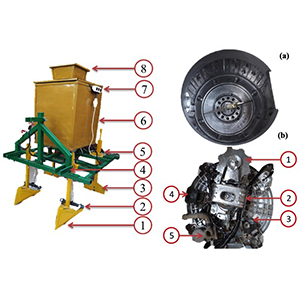Development of treated cardboard waste injection machine into the sandy soils

Published: 21 July 2022
Abstract Views: 1043
PDF: 264
Appendix: 86
Appendix: 86
Publisher's note
All claims expressed in this article are solely those of the authors and do not necessarily represent those of their affiliated organizations, or those of the publisher, the editors and the reviewers. Any product that may be evaluated in this article or claim that may be made by its manufacturer is not guaranteed or endorsed by the publisher.
All claims expressed in this article are solely those of the authors and do not necessarily represent those of their affiliated organizations, or those of the publisher, the editors and the reviewers. Any product that may be evaluated in this article or claim that may be made by its manufacturer is not guaranteed or endorsed by the publisher.
Similar Articles
- Andrea De Montis, Simone Caschili, Amedeo Ganciu, Antonio Ledda, Filippo Paoli, Federico Puddu, Mario Barra, Strategic environmental assessment implementation of transport and mobility plans. The case of Italian regions and provinces , Journal of Agricultural Engineering: Vol. 47 No. 2 (2016)
- Enrico Antonio Chiaradia, Arianna Facchi, Olfa Gharsallah, Marco Romani, Gian Battista Bischetti, Claudio Gandolfi, Water balance of rice plots under three different cultivation methods: first season results , Journal of Agricultural Engineering: Vol. 44 No. s2 (2013): Proceedings of the 10th Conference of the Italian Society of Agricultural Engineering
- Hamil Uribe, Rodrigo Figueroa, Luis Llanos, Assessment of linear anionic polyacrylamide application to irrigation canals for seepage control , Journal of Agricultural Engineering: Vol. 44 No. s2 (2013): Proceedings of the 10th Conference of the Italian Society of Agricultural Engineering
- Francesco M. Tangorra, Aldo Calcante, Stefano Nava, Gabriele Marchesi, Massimo Lazzari, Design and testing of a GPS/GSM collar prototype to combat cattle rustling , Journal of Agricultural Engineering: Vol. 44 No. 2 (2013)
- Andrea Peruzzi, Luisa Martelloni, Christian Frasconi, Marco Fontanelli, Michel Pirchio, Michele Raffaelli, Machines for non-chemical intra-row weed control in narrow and wide-row crops: a review , Journal of Agricultural Engineering: Vol. 48 No. 2 (2017)
- Melis Inalpulat, Monitoring and multi-scenario simulation of agricultural land changes using Landsat imageries and future land use simulation model on coastal of Alanya , Journal of Agricultural Engineering: Vol. 55 No. 1 (2024)
- Elena Bresci, Antonio Giacomin, Federico Preti, Experiences of improving water access in rural areas in Guatemala , Journal of Agricultural Engineering: Vol. 44 No. s2 (2013): Proceedings of the 10th Conference of the Italian Society of Agricultural Engineering
- Pasquale Dal Sasso, Giuseppe Ruggiero, Maria Antonella Ottolino, Giuseppe Verdiani, The role of agroforestry areas of the province of Bari in the absortion of carbon dioxide , Journal of Agricultural Engineering: Vol. 43 No. 1 (2012)
- Niccolò Pampuro, Alessio Facello, Eugenio Cavallo, Energy and pressure requirements for compression of swine solid fraction compost , Journal of Agricultural Engineering: Vol. 44 No. s2 (2013): Proceedings of the 10th Conference of the Italian Society of Agricultural Engineering
- Francesco Barreca, Giuseppe Cardinali, Carmelo Riccardo Fichera, Luigi Lamberto, Giuseppe Modica, A fuzzy-based model to implement the global safety buildings index assessment for agri-food buildings , Journal of Agricultural Engineering: Vol. 45 No. 1 (2014)
<< < 9 10 11 12 13 14 15 16 17 18 > >>
You may also start an advanced similarity search for this article.

 https://doi.org/10.4081/jae.2022.1354
https://doi.org/10.4081/jae.2022.1354







